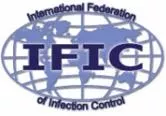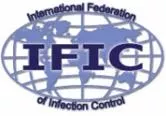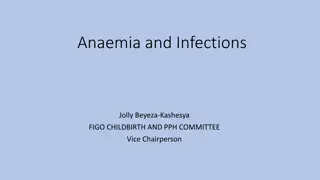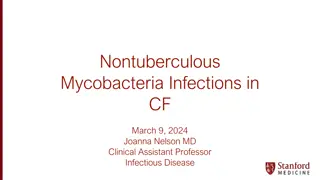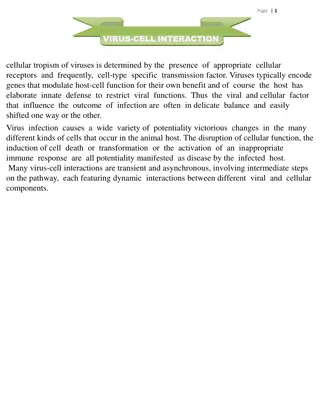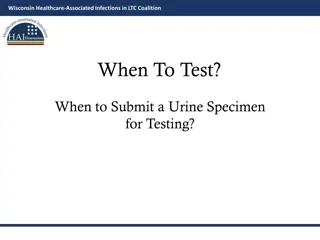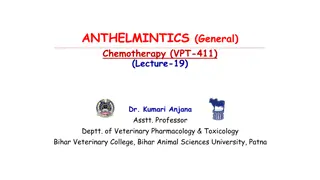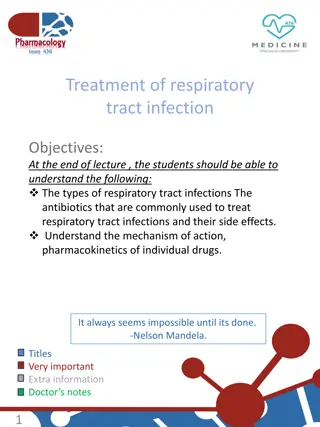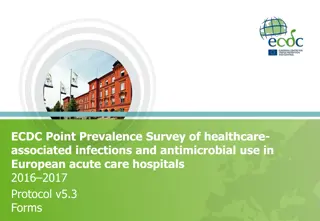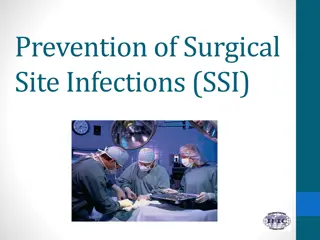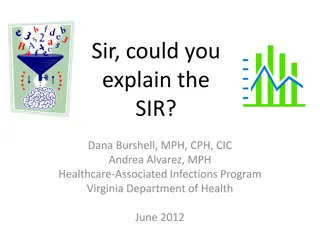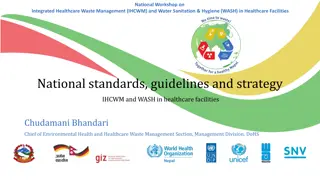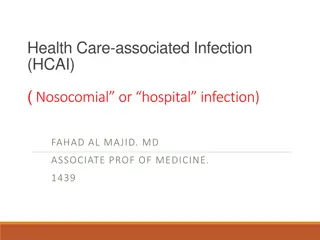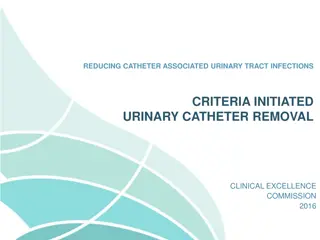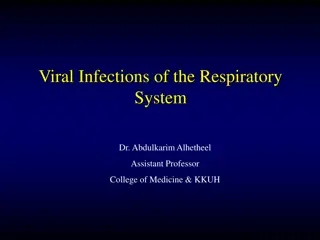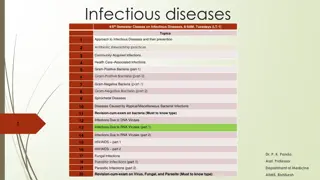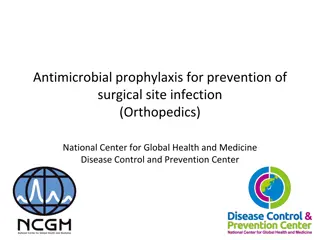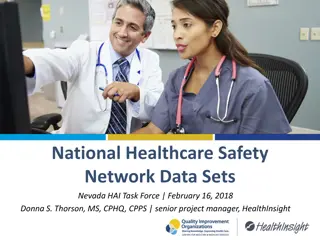Healthcare-Associated Infections in Special Populations
Delve into the vulnerabilities of special populations like geriatrics, pediatrics, burns patients, and more to healthcare-associated infections. Learn about specific risk factors, infection prevention strategies, and respiratory, skin, and diarrhea risk factors unique to geriatric patients.
Download Presentation

Please find below an Image/Link to download the presentation.
The content on the website is provided AS IS for your information and personal use only. It may not be sold, licensed, or shared on other websites without obtaining consent from the author. Download presentation by click this link. If you encounter any issues during the download, it is possible that the publisher has removed the file from their server.
E N D
Presentation Transcript
Learning objectives December 1, 2013 1. Identify special populations and their specific features 2. Describe specific risk factors of each special population that make it vulnerable to healthcare-associated infections 3. For any special population, outline additional methods for the prevention of healthcare-associated infections 2
Time involved December 1, 2013 60 minutes 3
Special populations December 1, 2013 Geriatrics Paediatrics Burns Behavioural health Ambulatory/Community care Immunocompromised populations Endoscopy 4
Basic Infection Prevention and Control (IP&C) Strategies December 1, 2013 Hand hygiene Standard precautions/routine practices Isolation/precautions Staff education Aseptic techniques Vaccination 5
Geriatrics - 1 December 1, 2013 Susceptibility of the elderly to infection is a result of underlying illness multiple medications alterations in immune function Residents of nursing homes or long-term care facilities are particularly at risk 6
Geriatrics - 2 December 1, 2013 Most frequent problems Respiratory tract infections Urinary tract infections Gastrointestinal infections Skin and soft tissue infections 7
Geriatrics Respiratory Risk Factors Swallowing disorders or poor gag reflex with aspiration Impaired mucociliary clearance Increased esophageal reflux Immobility Dehydration December 1, 2013 8
Geriatrics Skin Risk Factors December 1, 2013 Chronic oedema Venous insufficiency Unrecognised trauma Diabetes mellitus Dry skin 9
Geriatrics Diarrhoea Risk Factors December 1, 2013 A significant cause of morbidity, particularly in institutionalised older persons. Pathogens may be spread by ingestion of microorganisms or toxins from 1. an infected person 2. contaminated food or water 3. contaminated objects in the environment, or 4. infected animals 10
Preventing infections December 1, 2013 Infection Prevention Urinary tract infection Adequate hydration Good personal hygiene Mobilisation Avoid bladder catheters Vaccination Cohorting patients with respiratory illness Limiting group activities and communal dining during influenza outbreaks Mobilisation Adequate hydration Mobilisation Keeping the patient dry Providing nutritional support Using antipressure devices Early implementation of cohorting or room closure Reinforcement of environmental disinfection Hand hygiene Isolation precautions Bronchitis and pneumonia Pressure ulcers Diarrhoeal illnesses 11
Paediatrics December 1, 2013 Youth and immature immune systems make children more susceptible to infections Close contact with patients, siblings and family, uncontrolled body fluids, and play areas create unique opportunities for the spread of infection 12
Paediatrics - Risks December 1, 2013 Children at higher risk for infections those in intensive care patients with cancer solid organ transplant and haematopoietic cell transplantation recipients neonates 13
Paediatrics Prevention Infection/Risks Prevention December 1, 2013 Communicable diseases Vaccinate according to national guidelines Mothers should be instructed on hygienic methods Proper cleaning and disinfection of breast pumps Frequent cleaning of toys and environment Avoid high-risk toys, such as soft/stuffed toys, that are difficult to clean and dry Patients should be screened; isolation/precautions initiated while awaiting a diagnosis. Breast milk and infant formula Toys Viral respiratory and gastrointestinal illnesses 14
Burns December 1, 2013 Have a major impact on cellular and humeral immune systems; predispose patients to infection Burn causes mechanical disruption of the skin; allows skin and environmental microbes to invade deeper tissues As burn size increases, the risk of infection increases 15
Burns Prevention- 1 December 1, 2013 Strict aseptic technique Use of sterile gloves and dressing materials Wearing masks for dressing changes Spatial separation of patients, either using single rooms or cubicles 16
Burns Prevention - 2 December 1, 2013 Hand hygiene before and after patient contact Standard precautions/routine practices Protective apparel (aprons, gowns) before each patient contact Changing gloves when soiled and before continuing with care at another site on the same patient Cleaning and disinfection of reusable equipment before use on another patient 17
Burns Prevention - 3 December 1, 2013 Restrict plants and flowers at the bedside Restrict non-washable toys (stuffed animals, cloth objects) for paediatric burn patients Place catheters through unburned skin or frequent change of the catheter to decrease risk of infection 18
Burns Prevention - 4 December 1, 2013 Isolate patients colonised with multiply resistant microorganisms in single rooms or cubicles Hydrotherapy used routinely in some facilities; has been associated with outbreaks Some prefer to use local wound care with sterile saline solution instead If hydrotherapy used, shower tables are less risky than immersion Rinse the tanks or equipment with sodium hypochlorite after each use 19
Behavioural Health December 1, 2013 Behavioural health care provides prevention, intervention and treatment services in these areas Mental health, Substance abuse Development disabilities Sexualities 20
Behavioural Health - Prevention - 1 Practice standard precautions/routine practices Staff working with children vaccinated for typical childhood illnesses Inpatient influenza and pneumococcal immunisation program for adults; children up-to-date on immunisations December 1, 2013 21
Behavioural Health - Prevention - 2 Prevent mixing of patient clothing; special consideration for clothing of patients with incontinence, wound infections, or lesions, and suspected or confirmed cases of scabies or lice Provide patients with a caddy or basket to keep personal toiletry items if they share a bathroom Disposable paper mats for individual shower use; protect from transmission of athlete s foot (Tinea pedis) December 1, 2013 22
Behavioural Health - Prevention - 3 Lice and scabies procedures Identification of illness Monitoring for transmission Treatment (includes staff monitoring of the application of treatment) and follow-up Housekeeping procedures December 1, 2013 23
Behavioural Health - Prevention - 4 Provide disposable razors for shaving; discard after use in an appropriate sharps container If electric shavers provided, have a protocol for cleaning and disinfecting the shaver after use For electroconvulsive therapy Hand hygiene Use of gloves Cleaning and disinfection of equipment Bite blocks and laryngoscope blades require high-level disinfection December 1, 2013 24
Ambulatory/Community Care December 1, 2013 Provision of health care to patients who do not remain overnight Physician s surgeries Clinics Dental surgeries Diagnostic treatment centres Physical and occupational therapy centres 25
Ambulatory/Community Care December 1, 2013 Overall risk of HAIs lower in ambulatory/community settings than in hospitals Visits are brief, environmental contamination lower, less invasive procedures performed, and population healthier Risks: waiting areas, procedures 26
Ambulatory/Community Care December 1, 2013 Infection/Risks Respiratory illness Prevention Respiratory hygiene / respiratory etiquette Wear a surgical mask and place in a separate room with the door closed Communicable diseases (tuberculosis, chickenpox, measles, mumps, rubella, bacterial meningitis) Toys Limit sharing Easily cleanable Clean, disinfect/sterilise properly; use of safer devices to reduce the risk of needle- stick injuries Instruments 27
Immunocompromised Populations - 1 December 1, 2013 Severe neutropenia of treatment regimens and certain underlying diseases, and invasive devices and procedures, result in a high frequency of infection in these patients 28
Immunocompromised Populations - 2 December 1, 2013 Four broad categories of risk factors: 1. Neutropenia (granulocytopenia) 2. Immune system defects 3. Destruction of protective barriers, e.g., skin and mucous membranes 4. Environmental contamination/alteration of microbial flora 29
Immunocompromised Populations - Risks December 1, 2013 Ventilation Construction/renovation Equipment Plants Play areas and toys Health-care workers Visitors Skin and oral care 30
Immunocompromised Populations Prevention - 1 December 1, 2013 Patient-focused Good oral and dental hygiene important oral cavity a reservoir for microorganisms severe mucositis predisposes the spread of microorganisms into the bloodstream Patients and family members, as well as healthcare workers, should be taught the importance of hand hygiene 31
Immunocompromised Populations Prevention - 2 December 1, 2013 Staff-visitor-focused Screening programs for communicable infections, especially during the appropriate seasons for certain illnesses Restrict from direct patient care activities all healthcare workers with communicable infections 32
Immunocompromised Populations Prevention - 3 Environment-focused Isolation/precautions techniques are debateable; there are insufficient data to recommend the use of additional protective precautions Prevent dust accumulation with daily cleaning of frequently touched horizontal surfaces Avoid cleaning methods that generate dust Close doors to patient rooms while any vacuuming takes place nearby Exclude plants and flowers Clean toys regularly and when visibly soiled or mouthed Avoid toys that cannot be washed or disinfected after use Immunocompromised patients should avoid construction or renovation areas December 1, 2013 33
Endoscopy December 1, 2013 Risks due to the complexity of the instruments Microorganisms contaminating the equipment might be introduced into the patient, or patient s own microorganisms may be spread by the endoscope (rare) Outbreaks have been caused by inadequate cleaning/disinfection of endoscopes or accessories between patients contaminated water rinses or contaminated automatic endoscope reprocessors 34
Endoscopes Internal channels for air, water, aspiration, and accessories exposed to body fluids and other contaminants Cleaning is critical Six steps for re-processing: Cleaning Rinsing Disinfection Rinsing Drying Storage December 1, 2013 35
Endoscopy Protocols - 1 Set-up Endoscopic procedure room designated as clean areas Separate contaminated areas where accessories and specimens are handled from clean counter areas Cleaning Manual cleaning important; include brushing, using a medical grade, low-foaming, and neutral pH detergent Use automatic disinfection, rinsing, and drying of all exposed surfaces of the endoscope, when available. Water for automatic endoscope reprocessors should be free from particles and microorganisms. Isopropyl alcohol for flushing endoscope channels as part of the drying process December 1, 2013 36
Endoscopy Protocols - 2 December 1, 2013 Use single-use accessories when possible Discard rubber valves covering the working channel after procedures involving the passage of biopsy forceps, guidewires, and/or other accessories 37
Key Points December 1, 2013 Basic infection prevention strategies apply, regardless of patient type or setting Additional strategies may be required for special populations Strategies designed for hospitals may need adapting for other health care settings 38
Additional Reading - 1 1. Geriatrics: SHEA/APIC Guideline: Infection prevention and control in the long-term care facility, 2008. http://www.apic.org/Content/NavigationMenu/Practice Guidance/APIC-SHEA_Guideline.pdf 2. Endoscopes: Multisociety guideline on reprocessing flexible gastrointestinal endoscopes: 2011. http://www.asge.org/uploadedFiles/Publications_and_Produ cts/Practice_Guidelines/Multisociety%20guideline%20on%20 reprocessing%20flexible%20gastrointestinal.pdf and WGO- OMGE and OMED Practice Guideline: Endoscope Disinfection, 2005. http://www.omed.org/downloads/pdf/guidelines/wgo_ omed_endoscope_disinfection.pdf December 1, 2013 39
Additional Reading - 2 December 1, 2013 1. Burns: European Practice Guidelines for Burn Care, 2002. http://www.euroburn.org/e107_files/downloads/guidel inesburncare.pdf 2. Ambulatory care: Infection Control Manual for Ambulatory Care Clinics, Texas Department of State Health Services, 2009. http://www.dshs.state.tx.us/idcu/health/infection_cont rol/manual/InfectionControlManual.pdf 40
Additional Reading - 3 December 1, 2013 1. Immunocompromised: Guidelines for Preventing Infectious Complications among Hematopoietic Cell Transplantation Recipients: A Global Perspective. Biol Blood Marrow Transplant 15: 1143-1238 (2009). http://www.shea- online.org/Assets/files/guidelines/2009_HSCT_Guideline.pdf 41
Quiz 1. Mobilisation of older patient is important measure in prevention of urinary tract and respiratory tract infections and pressure ulcers. T/F Specific measures for prevention of burn wound infections include: a) Hand hygiene before and after patient contact b) Frequent change of vascular catheters in some circumstances c) Disinfection of hydrotherapy tanks with sodium hypochlorite solution d) All of the above Destruction of protective skin barriers is a risk factor for highly immunocompromised patients. T/F December 1, 2013 2. 3. 42
International Federation of Infection Control IFIC s mission is to facilitate international networking in order to improve the prevention and control of healthcare associated infections worldwide. It is an umbrella organisation of societies and associations of healthcare professionals in infection control and related fields across the globe . The goal of IFIC is to minimise the risk of infection within healthcare settings through development of a network of infection control organisations for communication, consensus building, education and sharing expertise. For more information go to http://theific.org/ December 1, 2013 43




